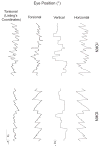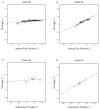Rotational and translational optokinetic nystagmus have different kinematics
- PMID: 17320142
- PMCID: PMC1862819
- DOI: 10.1016/j.visres.2006.12.011
Rotational and translational optokinetic nystagmus have different kinematics
Abstract
We studied the dependence of ocular torsion on eye position during horizontal optokinetic nystagmus (OKN) elicited by random-dot translational motion (tOKN) and prolonged rotation in the light (rOKN). For slow and quick phases, we fit the eye-velocity axis to vertical eye position to determine the tilt angle slope (TAS). The TAS for tOKN was 0.48 for both slow and quick phases, close to what is found during translational motion of the head. The TAS for rOKN was less for both slow (0.11) and quick phases (0.26), close to what is found during rotational motion of the head. Our findings are consistent with the notion that translational and rotational optic flow are processed differently by the brain and that they produce different 3-D eye movement commands that are comparable to the different commands generated in response to vestibular signals when the head is actually translating or rotating.
Figures




References
-
- Adeyemo B, Angelaki DE. Similar kinematic properties for ocular following and smooth pursuit eye movements. J Neurophysiol. 2005;93:1710–1717. - PubMed
-
- Berthoz A, Pavard B, Young LR. Perception of linear horizontal self-motion induced by peripheral vision (linearvection) basic characteristics and visual-vestibular interactions. Exp Brain Res. 1975;23:471–489. - PubMed
-
- Busettini C, Miles FA, Schwarz U. Ocular responses to translation and their dependence on viewing distance. II. Motion of the scene. J Neurophysiol. 1991;66:865–878. - PubMed
Publication types
MeSH terms
Grants and funding
LinkOut - more resources
Full Text Sources

